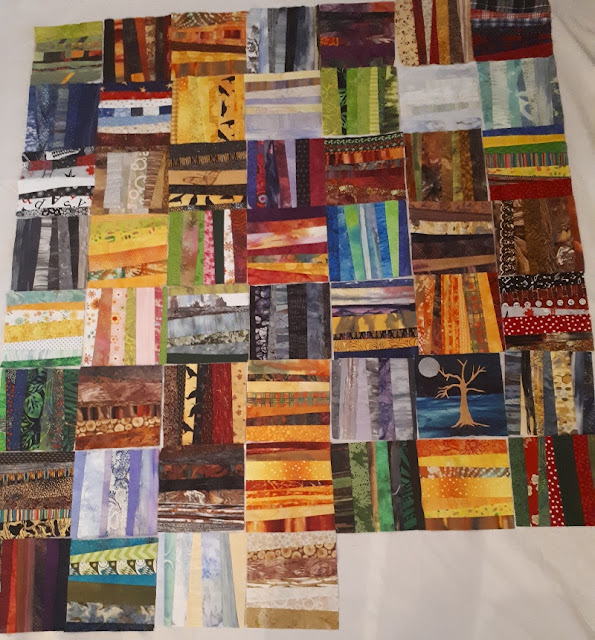The meaning of the title will become apparent further down in this blog
It was gratifying to get so many responses to my last blog featuring my Covid Crazy Quilt. One friend emailed me, “In these times of Covid and restrictions, it is interesting to hear what people are up to. Quilting is your way of remembering these many days. Your blog made me think of my way of coping ...”
Coping is a big word these days, and no wonder. Covid isn’t the only thing we’re dealing with. Here in British Columbia, a massive storm has wrought devastation to many people in our province. It’s destroyed homes, farm animals, transportation routes, taken lives, and left us bewildered and anxious. After record heat waves and forest fires this summer, now this. What’s next?

When I checked the dictionary, I found this definition of coping: “Something a person does to deal with a difficult situation.” We need to find ways to deal with these difficult situations, or they will destroy our hope and our emotional health.
And if I dig around a little deeper, I find lots of advice and tips. They all sound so good:
In my recent post, I wrote about one method of coping, which took up about one hour a week. If you subtract about 50 hours for sleeping, there were 167 other hours left in the week to fill with other coping mechanisms. And the truth is, that didn’t always go so well.
Those walks I planned to take? The projects I started? The intentions I did not fulfill? The kind words I wanted to always speak to my resident sweetie? The positive thoughts and affirmations I wanted to fill my day with? Ha. Often the wheels have fallen off my coping mechanisms. I loaf around on the sofa, eat too much, doom-scroll through my phone for bad-news stories ... and just listing my shortcomings isn’t helping at all.
I’ve been pondering this. Why is it that I feel I need to be so much better at coping than I often am? Shouldn’t I be in control of my feelings, not have these blue days (or weeks) when nothing goes right? At my ripe old age, shouldn’t I have figured out “the secret?”
That’s when I realize that I’m equating “coping” with “control.” Coping methods often help us get through or around or over anxieties, sadness, frustrations and anger, but these methods cannot remove the situations we are facing.
Whatever the situation you are dealing with – Covid, natural disasters, losses, root canals/toilet training/empty shelves at the grocery store/gasoline rationing, disease, __________ (fill in the blank with your own personal mountain to climb) – coping methods cannot change that.
As long as I am fighting against things I cannot control, I am fighting a losing battle. The limitations on our lives right now? That is Reality. The imperfections we carry within ourselves, so that coping mechanisms don’t always work? That is Reality.
I think back to my dad, as he struggled with the disabilities of old age; he, who loved to read and write and explore new places, was blind and in a wheel chair. “Ik mat los litte,” he told us, using the Frisian dialect of his youth. “I must let go.”
It’s what I need to do, too: let go of the mistaken belief I can control everything, that if only I could learn to cope better, all would be sunshine and light. It won’t be...and yet, as my dad did, I can find a measure of peace and equilibrium. I can be easier on myself and others, knowing we’re mostly doing our best, and (as Rumi said) “We are all just walking each other home.”
This blog finally found its legs when I read this, written by recovering alcoholic Holly Whitaker and posted at this site: https://cac.org/category/daily-meditations/2021/
“I’d always considered the word surrender to be blasphemous. Surrender was never a possibility to consider; it wasn’t something self-respecting, self-reliant folk like me do—we scheme around and bulldoze through whatever stands in our way.
... [But] Surrender is the strongest, most subversive thing you can do in this world. ... It’s a way of existing, a balancing act. For me, it looks like this: I pick up the baton and I run as far as I can, and I hand it over when I’m out of breath. Or actually maybe it’s like: I’m running with the baton, but the Universe is holding on to the other half of it, and we have an agreement that I’ll figure out the parts I can and hand over the parts I can’t.”
"Los litte," my dad would say. Let go.
Whittaker continues, “By surrendering to whatever is unfolding and by accepting what is ... you not only get a break from the exhaustion of having to control everything, but you also get to experience life, instead of what you think life owes you.
And, she ends by saying, “Hint: what life wants to give us is infinitely better than what we think it owes us.”
I've sewed the squares of my covid crazy quilt together, and will share the end result when I've figured out how to finish it. Don't hold your breath! Things take a little longer these days, and that's okay.


























